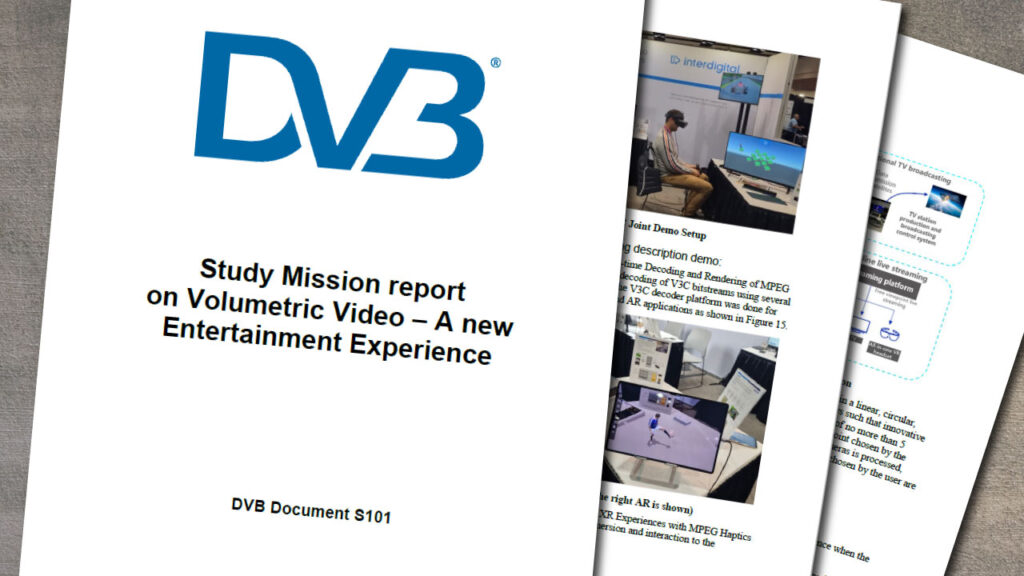Paul Higgs (Huawei) provides the background to the DVB Study Mission Report on Volumetric Video
Television has long focused on programming presented in a two-dimensional format, targeted at devices with more and more capability in terms of size, colour and quality. While this has been the mainstay format, consumers have, through the use of touchscreen devices, become accustomed to having a more interactive visual experience, which has allowed computer-generated content and natural scenes to be experienced from a personalized viewpoint. Content and service providers are looking towards being able to offer volumetric content, where the consumer can select their preferred view and watch it on flat screens as well as using 3D displays or virtual reality headsets, leveraging sophisticated video processing algorithms and computational graphics models.
In 2015 and 2016 already, DVB carried out a study mission to consider the opportunities that VR (virtual reality) technology could bring to broadcast-led media services while also understanding the potential pitfalls. The timing of the study mission coincided with a maturing of VR technology after the peak of its hype in the early part of the decade. At that time, consumers had generally been given a disappointing solution for VR and it had thus quite quickly lost favour, with an isolating and poor-quality entertainment experience, especially when seen alongside the 2D UHD content that was becoming available for typical entertainment scenarios.
Technological advances
More than six years on from the DVB Study Mission on Virtual Reality, we can certainly see that technological innovation has improved the perceptual performance of head-mounted displays, and more content acquisition and media production for high-quality three degrees of freedom and above are now available. However, content or genres that could be successful in the immersive domain largely remain elusive.
It was in this context that DVB initiated a study mission to look at what was now termed Volumetric Video, and to further understand the potential use cases alongside existing industry activity and technology developments.
The Study Mission on Volumetric Video kicked off in November 2022. Reporting to the DVB Commercial Module, the CM-SM-VV group would identify the potential service offerings while highlighting some key industry technologies and standards that could be used to realize commercial service scenarios in the future. As with all DVB study missions, the ultimate goal was to see where and how the DVB Project could potentially make a contribution to enabling standards-based approaches for those wishing to deploy services.
Study Mission report
The final report of the study mission was published on the DVB website in February 2024 as BlueBook S101.
It details some of the most recent developments and demonstrations of volumetric video technologies while also offering insights into an evolutionary path based on the service offerings of the last 30 years. Several use cases and exemplary service scenarios that have met with varying degrees of success in the industry are provided, along with an analysis of some of the current and evolving key technologies and standards that can be utilized in future large-scale service offerings.
The study mission found that there exists a reasonable level of industry activity around volumetric video, especially in the sports and artistic entertainment domains, as well as the presence of technologies that can bring interactivity and immersiveness to the user experience.
While the study mission report does not recommend any immediate standardization work by DVB, the
group concluded that the topic is worth exploring further. The report itself is publicly available and serves as the basis for inputs to relevant industry events, including an unconference session at DVB World 2024 (already held) and a subsequent workshop on volumetric video technology. A further step could involve an industry survey to understand whether support for specific immersive media use cases is strong enough to initiate work on commercial requirements within the DVB Project.
Paul Higgs is VP for Video Industry Development at Huawei. He chairs the DVB Technical Module group on DVB-I and also led the recent DVB Study Mission on Volumetric Video.
This article first appeared in issue 63 of DVB Scene magazine.

